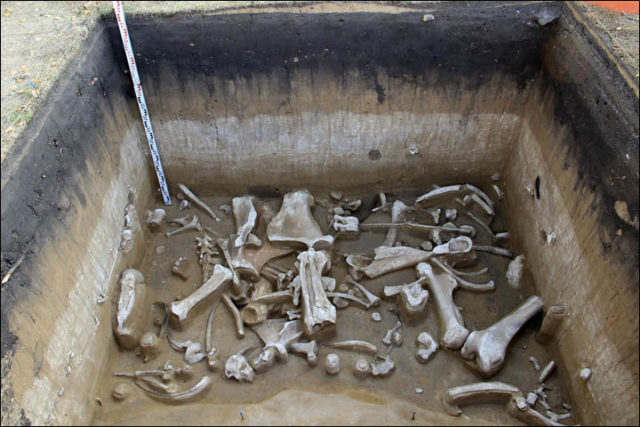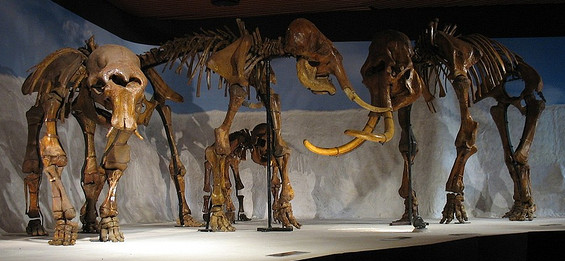A dig during the summer at the Volchya Griva mammoth graveyard has made a record haul of mammoth bones. Yet this was not the only surprising find.
In a pit that measured nine square meters, the paleontologist for Tomsk State University discovered remnants from eight extinct creatures.
In the collection of 785 discoveries experts also found some bones and teeth of bison, as well as those of a horse and most likely foxes or polar foxes and rodents. Yet this has not been confirmed yet.

The archaeologists had unearthed two bone-carrying levels, which is the normal way they are arranged at the Volchya Grive. They found a lot of interesting bones.
Before the archaeologists headed home, they dug further down in one location and then in another. They realized that there were at least ten more days of work. When they had gone deeper it was here that they discovered mammoth bones that they had never seen before.
There were at points more than 100 discoveries of limb bones, vertebrae, and ribs located in an area that was one square meter wide and half a meter deep. The new remains of the woolly mammoths that were discovered at the deeper level are incredibly well preserved.
They had been buried underneath a layer of clay and sand in a little slump for many years after animals had died. Archaeologists found a good number of anatomical joints that will be helpful in getting more information in finding out the locations and the reasons for the mammoths’ deaths, and also in identifying their age and size.
The previous digging location since the 1960s was in one location on the outer part of Mamontovoye (Mammoth) village. This place has been long known as the cemetery for extinct creatures.
The depth of the layer that contained the bones was 1.5 meters (4.9 ft). The archaeologists chose to check a new place that was located in the middle of the village. Locals had discovered these bones while digging trenches for water pipes and cellars.
The archaeologist used drilling equipment to discover the bone layer. When they discovered a suitable place, they cleaned the area of 3×3 square meters (9.8 ft).
They had dug the usual layer of 1.5 meters (4.9 ft) and had thought that this would have been the end, and then went for a small look around the surrounding area to search for similar places. But they chose to dig out two more shovelsful and discovered another layer that happened to be twice as rich in bones.
This was the first time that there was clear evidence of rodents discovered. The Predators had obviously come and chewed on the carcasses. The archaeologists could see traces of their teeth located on the bones.
The inner layer indicates that there was some break between two periods when mammoths came to this place. The archaeologists stated that they needed to study this area more thoroughly and had to continue to work there.
The lower layer they had discovered, judging by the geological time scale, existed of a ravine. The bones had been washed by water and were sealed within the dirt; this helped preserve them well.
The mammoth seen on the lower layer dated back to around 30,000 years old. They still need to make an analysis to get the exact age, but these were larger than mammoths that dated to 10,000 years ago.
Mammoths that were excavated in the lower layer were around 3 (9.8 ft) to 3.1 (10.1 ft) meters tall, while the mammoths that existed 10,000 years ago measured about 2.6 (8.5 ft) to 2.1 (6.8 ft) meters tall. If the volume is compared between the two, the mammoths that existed 30,000 years ago were twice as big as the later ones.
This is a known fact, and at this excavation site, the archaeologists can literally see the difference. The bones will be under radiocarbon examination to help with dating the remnants.
The significant differences in the mass of the mammoths from the lower and upper levels can be explained by the negative environment that later affected generations of mammoths as they went towards their extinction.

Several of the upper-level bones displayed traces of osteodystrophy, which means that they had suffered from a large mineral deficiency. Scientists refer to this as mineral starvation, Siberian Times reported.
This would have been the driving force behind their impulse to reach sodium rich soils like those at Volchya Griva and the resulting discovery thousands of years later.
Here is another Woolly Mammoth story from us: 39,000-year-old remains of a woolly mammoth were discovered in the Siberian permafrost
Siberian researchers have faith that this is just a small fragment of the treasure that Volchya Griva has to offer. This would have been a mineral oasis for the mammoths, and more bones in the thousand are likely waiting to be discovered.